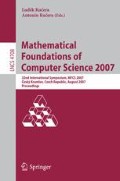Abstract
In computability theory, program self-reference is formalized by the not-necessarily-constructive form of Kleene’s Recursion Theorem (krt). In a programming system in which krt holds, for any preassigned, algorithmic task, there exists a program that, in a sense, creates a copy of itself, and then performs that task on the self-copy. Herein, properties complementary to krt are considered. Of particular interest are those properties involving the implementation of control structures. One main result is that no property involving the implementation of denotational control structures is complementary to krt. This is in contrast to a result of Royer, which showed that implementation of if-then-else — a denotational control structure — is complementary to the constructive form of Kleene’s Recursion Theorem. Examples of non-denotational control structures whose implementation is complementary to krt are then given. Some such control structures so nearly resemble denotational control structures that they might be called quasi-denotational.
This paper received support from NSF Grant CCR-0208616.
Access this chapter
Tax calculation will be finalised at checkout
Purchases are for personal use only
Preview
Unable to display preview. Download preview PDF.
References
Adami, C.: What do robots dream of? Science 314, 1093–1094 (2006)
Amtoft, T., Nikolajsen, T., Träff, J.L., Jones, N.: Experiments with implementations of two theoretical constructions. In: Meyer, A.R., Taitslin, M.A. (eds.) Logic at Botik 1989. LNCS, vol. 363, pp. 119–133. Springer, Heidelberg (1989)
Blum, M.: A machine independent theory of the complexity of recursive functions. Journal of the ACM 14, 322–336 (1967)
Blum, M.: On the size of machines. Information and Control 11, 257–265 (1967)
Bonfante, G., Kaczmarek, M., Marion, J.-Y.: A classification of viruses through recursion theorems. In: Computation and Logic in the Real World - Third Conference of Computability in Europe (CiE 2007). LNCS, vol. 4497, Springer, Berlin (2007)
Bongard, J., Zykov, V., Lipson, H.: Resilient machines through continuous self-modeling. Science 314, 1118–1121 (2006)
Case, J.: Periodicity in generations of automata. Mathematical Systems Theory 8, 15–32 (1974)
Case, J.: Infinitary self-reference in learning theory. Journal of Experimental and Theoretical Artificial Intelligence 6, 3–16 (1994)
Case, J., Moelius III, S.E.: Characterizing programming systems allowing program self-reference. In: Computation and Logic in the Real World - Third Conference of Computability in Europe (CiE 2007). LNCS, vol. 4497, pp. 125–134. Springer, Berlin (2007)
Case, J., Moelius III, S.E.: Properties complementary to program self-reference (expanded version). Technical report, University of Delaware (2007), Available at http://www.cis.udel.edu/~moelius/publications
Case, J., Jain, S., Suraj, M.: Control structures in hypothesis spaces: The influence on learning. Theoretical Computer Science 270(1-2), 287–308 (2002)
Conduit, R.: To sleep, perchance to dream. Science 315(5816), 1219–1220 (2007), A letter, including responses from C. Adami and from Lipson, H., Zykov, V., Bongard, J
Friedman, H.: [FOM] 305:Proofs of Godel’s Second. Communication to the Foundations of Mathematics electronic mailing list (December 21, 2006)
Jain, S., Nessel, J.: Some independence results for control structures in complete numberings. Journal of Symbolic Logic 66(1), 357–382 (2001)
Jones, N.: Computer implementation and applications of Kleene’s s-m-n and recursion theorems. In: Moschovakis, Y. (ed.) Logic From Computer Science. Mathematical Science Research Institute Publications, vol. 21, pp. 243–263. Springer, Heidelberg (1992)
Kleene, S.C.: On notation for ordinal numbers. Journal of Symbolic Logic 3, 150–155 (1938)
Machtey, M., Winklmann, K., Young, P.: Simple Gödel numberings, isomorphisms, and programming properties. SIAM Journal on Computing 7, 39–60 (1978)
Machtey, M., Young, P.: An Introduction to the General Theory of Algorithms. North Holland, New York (1978)
Manna, Z.: Mathematical theory of computation. MacGraw-Hill (1974). Reprinted, Dover (2003)
Manna, Z., Vuillemin, J.: Fixpoint approach to the theory of computation. Communications of the ACM 15(7), 528–536 (1972)
Riccardi, G.: The Independence of Control Structures in Abstract Programming Systems. PhD thesis, SUNY Buffalo (1980)
Riccardi, G.: The independence of control structures in abstract programming systems. Journal of Computer and System Sciences 22, 107–143 (1981)
Rogers, H.: Gödel numberings of partial recursive functions. Journal of Symbolic Logic, 23:331–341 (1958)
Rogers, H.: Theory of Recursive Functions and Effective Computability. McGraw Hill, New York (1967). Reprinted, MIT Press, Cambridge (1987)
Royer, J.: A Connotational Theory of Program Structure. LNCS, vol. 273. Springer, Heidelberg (1987)
Royer, J., Case, J.: Subrecursive Programming Systems: Complexity and Succinctness. Progress in Theoretical Computer Science. Birkhäuser, Boston (1994)
Smullyan, R.: Theory of formal systems. Annals of Mathematics Studies (1961)
Winskel, G.: The Formal Semantics of Programming Languages: An Introduction. Foundations of Computing Series. MIT Press, Cambridge (1993)
Author information
Authors and Affiliations
Editor information
Rights and permissions
Copyright information
© 2007 Springer-Verlag Berlin Heidelberg
About this paper
Cite this paper
Case, J., Moelius, S.E. (2007). Properties Complementary to Program Self-reference. In: Kučera, L., Kučera, A. (eds) Mathematical Foundations of Computer Science 2007. MFCS 2007. Lecture Notes in Computer Science, vol 4708. Springer, Berlin, Heidelberg. https://doi.org/10.1007/978-3-540-74456-6_24
Download citation
DOI: https://doi.org/10.1007/978-3-540-74456-6_24
Publisher Name: Springer, Berlin, Heidelberg
Print ISBN: 978-3-540-74455-9
Online ISBN: 978-3-540-74456-6
eBook Packages: Computer ScienceComputer Science (R0)

